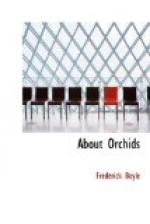Many persons indifferent to gardening—who are repelled, indeed, by its prosaic accompaniments, the dirt, the manure, the formality, the spade, the rake, and all that—love flowers nevertheless. For such these plants are more than a relief. Observe my Oncidium. It stands in a pot, but this is only for convenience—a receptacle filled with moss. The long stem feathered with great blossoms springs from a bare slab of wood. No mould nor peat surrounds it; there is absolutely nothing save the roots that twine round their support, and the wire that sustains it in the air. It asks no attention beyond its daily bath. From the day I tied it on that block last year—reft from home and all its pleasures, bought with paltry silver at Stevens’ Auction Rooms—I have not touched it save to dip and to replace it on its hook. When the flowers fade, thither it will return, and grow and grow, please Heaven, until next summer it rejoices me again; and so, year by year, till the wood rots. Then carefully I shall transfer it to a larger perch and resume. Probably I shall sever the bulbs without disturbing them, and in seasons following two spikes will push—then three, then a number, multiplying and multiplying when my remotest posterity is extinct. That is, so Nature orders it; whether my descendants will be careful to allow her fair play depends on circumstances over which I have not the least control.
For among their innumerable claims to a place apart among all things created, orchids may boast immortality. Said Sir Trevor Lawrence, in the speech which opened our famous Congress, 1885: “I do not see, in the case of most of them, the least reason why they should ever die. The parts of the orchideae are annually reproduced in a great many instances, and there is really no reason they should not live for ever unless, as is generally the case with them in captivity, they be killed by errors in cultivation.” Sir Trevor was addressing an assemblage of authorities—a parterre of kings in the empire of botany—or he might have enlarged upon this text.
The epiphytal orchid, to speak generally, and to take the simple form, is one body with several limbs, crowned by one head. Its circulation pulsates through the whole, less and less vigorously, of course, in the parts that have flowered, as the growing head leaves them behind. At some age, no doubt, circulation fails altogether in those old limbs, but experience does not tell me distinctly as yet in how long time the worn-out bulbs of an Oncidium or a Cattleya, for example, would perish by natural death. One may cut them off when apparently lifeless, even beginning to rot, and under proper conditions—it may be a twelvemonth after—a tiny green shoot will push from some “eye,” withered and invisible, that has slept for years, and begin existence on its own account. Thus, I am not old enough as an orchidacean to judge through how many seasons these plants will maintain a limb apparently superfluous. Their charming disposition is characterized above all things by caution and foresight. They keep as many strings to their bow, as many shots in their locker, as may be, and they keep them as long as possible. The tender young head may be nipped off by a thousand chances, but such mishaps only rouse the indomitable thing to replace it with two, or even more. Beings designed for immortality are hard to kill.




